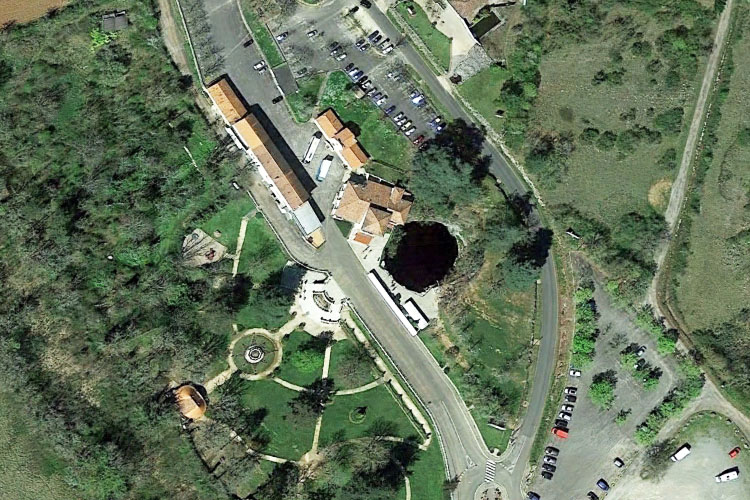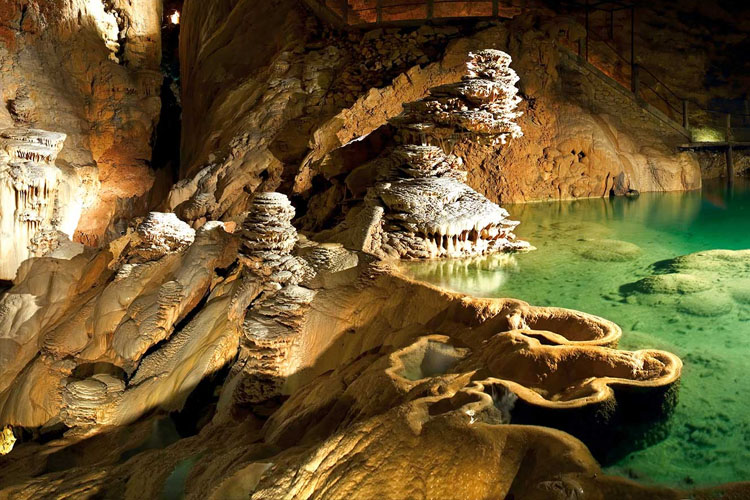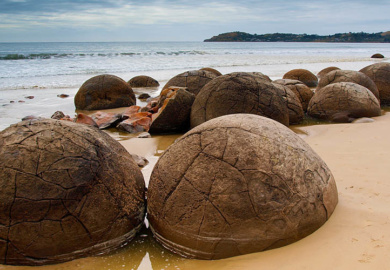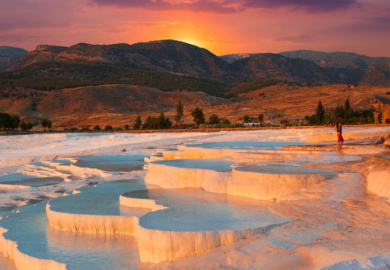Padirac Chasm and Caves
The Padirac Chasm (Cave) is one of the most impressive natural wonders of France and although it is widely visited by the French themselves, it remains little known outside of the country. Also known as the Gouffre de Padirac, it is located near the town of Gramat in the southern region of France and a little over 100 miles north of the Pyrenees Mountains that form the border with Spain. A spectacular sinkhole entrance leads to an underground wonderland of subterranean rivers, lakes and ornate chambers.
The mouth of Padirac Chasm (Cave) is roughly 99 m (325 ft) around its rim with a diameter of approximately 35 meters (115 ft). The sinkhole, which formed when the roof of a gigantic cavern collapsed, reaches a depth of around 100 meters where visitors will discover a beautiful and mysterious underground river that can be explored by boat.

Padirac Cave – The stairs to the entrance
The mouth of the sinkhole seems enormous when viewed from the top of the stairs, but becomes no more than a small skylight of blue when seen from below. A raised walkway goes above the huge piles of rocks that were scattered by the collapse of the ceiling and the leads down to the entrance of the cave galleries.
Padirac cave was first explored by Edouard-Alfred Martell on the 9th of July 1889. He was entranced by what he discovered and marveled that he was one of the first humans to see caverns that rivalled the finest cathedrals of Europe. He became determined to share this wonderful discovery and together with George Beamish, heir to the Irish brewing dynasty, he set about establishing one of the most important destinations in France. It first opened in April 1899 and today the cave system attracts around 400,000 visitors every year.
The Legends of Padirac Chasm (Cave)
Strange legends have always been associated with the chasm of Padirac which must have seemed even more mysterious before geologists explained how the cave had been formed and tourism was encouraged in the area.
St. Martin
One of the key legends is that of Saint Martin. The devil apparently formed the chasm with his heel and challenged Saint Martin to leap the impossible. He agreed that if Saint Martin succeeded then the souls of the peasants he was about to take would all be saved. Saint Martin pushed his mule and miraculously jumped the gap. Where his astounding mule landed the hoof marks can still be seen even today!
The Treasure of Padirac Cave
There is a local legend that during the 100 years’ war, English soldiers had been fighting and looting at Rocamadour where they had burnt the preserved body of St. Rocamadour (possibly Zacchaeus himself). Burdened with treasures but desperate to keep moving, they are said to have marched on to Alvignac and then Padirac where they hid the treasure somewhere in the chasm. Another version of the story claims that the English were fleeing towards the coast and hid the treasure before going on to Rocamadour.
Ghostly Blue Flames
Another fable claims that from time-to-time ghostly blue flames could be seen coming out of the sinkhole. Strangely, there may be some truth in this story. The origins of this tale probably date back to the 15th and 16th centuries during which time Potassium nitrate (Saltpeter) was mined in the area. This was an essential ingredient of gunpowder and other explosives. When burnt, Potassium nitrate turns flames a brilliant but ghostly violet colour.







